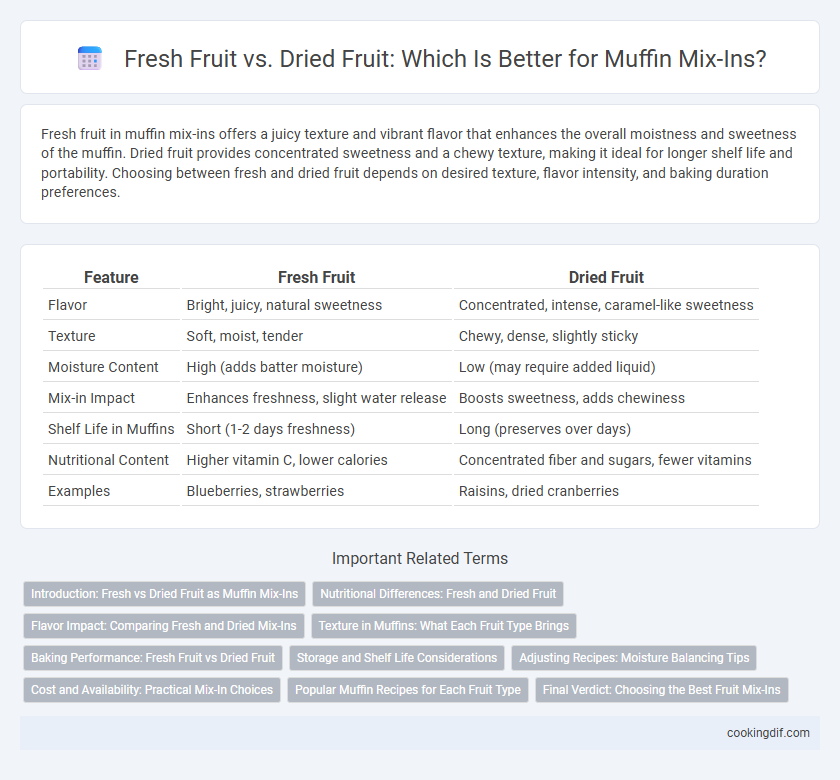Fresh fruit in muffin mix-ins offers a juicy texture and vibrant flavor that enhances the overall moistness and sweetness of the muffin. Dried fruit provides concentrated sweetness and a chewy texture, making it ideal for longer shelf life and portability. Choosing between fresh and dried fruit depends on desired texture, flavor intensity, and baking duration preferences.
Table of Comparison
| Feature | Fresh Fruit | Dried Fruit |
|---|---|---|
| Flavor | Bright, juicy, natural sweetness | Concentrated, intense, caramel-like sweetness |
| Texture | Soft, moist, tender | Chewy, dense, slightly sticky |
| Moisture Content | High (adds batter moisture) | Low (may require added liquid) |
| Mix-in Impact | Enhances freshness, slight water release | Boosts sweetness, adds chewiness |
| Shelf Life in Muffins | Short (1-2 days freshness) | Long (preserves over days) |
| Nutritional Content | Higher vitamin C, lower calories | Concentrated fiber and sugars, fewer vitamins |
| Examples | Blueberries, strawberries | Raisins, dried cranberries |
Introduction: Fresh vs Dried Fruit as Muffin Mix-Ins
Fresh fruit provides a juicy texture and vibrant flavor to muffins, enhancing moisture and natural sweetness in every bite. Dried fruit offers concentrated taste and a chewy consistency, making it a convenient option with longer shelf life and less impact on batter moisture. Choosing between fresh and dried fruit mix-ins depends on the desired texture, sweetness intensity, and baking time in muffin recipes.
Nutritional Differences: Fresh and Dried Fruit
Fresh fruit in muffins provides higher water content and fewer calories, while dried fruit delivers concentrated natural sugars and increased fiber. The drying process reduces vitamin C levels but enhances the concentration of minerals like potassium and iron. Choosing between fresh and dried fruit affects the muffin's texture, sweetness, and nutritional profile significantly.
Flavor Impact: Comparing Fresh and Dried Mix-Ins
Fresh fruit mix-ins deliver vibrant, juicy flavors that enhance muffin moisture and highlight natural sweetness, while dried fruit offers concentrated, intense taste with a chewy texture that intensifies the overall flavor profile. The water content in fresh fruit can alter batter consistency, leading to softer crumb, whereas dried fruit maintains dough structure and provides bursts of sweetness without excess moisture. Choosing between fresh and dried fruit depends on desired texture and flavor impact, with fresh fruit best for bright, delicate notes and dried fruit ideal for rich, robust taste enhancements.
Texture in Muffins: What Each Fruit Type Brings
Fresh fruit adds moisture and a juicy texture to muffins, creating a tender crumb and bursts of natural sweetness. Dried fruit contributes a chewy consistency and concentrated flavor, providing a denser bite and caramelized notes throughout the muffin. Balancing fresh and dried fruit mix-ins impacts the overall mouthfeel and structural integrity, influencing muffin softness and chewiness.
Baking Performance: Fresh Fruit vs Dried Fruit
Fresh fruit in muffin mix-ins adds moisture and natural sweetness, enhancing tenderness but may cause batter sogginess and uneven baking due to high water content. Dried fruit offers concentrated flavor and a chewy texture, providing consistent baking performance without extra moisture, which helps maintain muffin structure and rise. Choosing between fresh and dried fruits depends on desired texture, moisture level, and baking stability in muffin recipes.
Storage and Shelf Life Considerations
Fresh fruit in muffins offers vibrant flavor but has a shorter shelf life, increasing the risk of spoilage and moisture affecting texture. Dried fruit provides extended storage stability, resisting mold and reducing moisture-related issues, making it ideal for longer shelf life in baked goods. Proper storage in airtight containers away from heat and humidity further preserves the quality of both fresh and dried fruit mix-ins.
Adjusting Recipes: Moisture Balancing Tips
Incorporating fresh fruit into muffin recipes requires reducing liquid ingredients to balance the added moisture, while dried fruit necessitates soaking or rehydration to prevent dryness and uneven baking. Adjusting flour quantities can also help maintain the proper batter consistency when substituting between fresh and dried fruits. Proper moisture balancing ensures muffins stay tender and evenly textured regardless of the fruit mix-ins.
Cost and Availability: Practical Mix-In Choices
Fresh fruit mix-ins offer vibrant flavor and moisture but tend to be more expensive and less available year-round compared to dried fruit. Dried fruit provides a cost-effective alternative with extended shelf life and consistent availability, making it a practical choice for muffin recipes. Considering budget constraints and supply reliability, dried fruit mix-ins often deliver greater value and convenience.
Popular Muffin Recipes for Each Fruit Type
Fresh fruit mix-ins like blueberries and raspberries create moist, tender muffins with vibrant flavor and natural sweetness, perfect for classic recipes such as blueberry muffins and strawberry crumb muffins. Dried fruit options such as raisins, cranberries, and chopped dates add concentrated sweetness and chewy texture, commonly featured in bran muffins and spiced apple-date muffins. Popular muffin recipes leverage the unique characteristics of each fruit type to enhance taste and texture, catering to different flavor preferences and baking styles.
Final Verdict: Choosing the Best Fruit Mix-Ins
Fresh fruit mix-ins in muffins offer vibrant flavor and moisture, enhancing texture but can release excess water during baking. Dried fruit provides concentrated sweetness and chewy texture without adding moisture, ensuring consistent muffin structure. Choosing the best fruit mix-ins depends on baking goals: use fresh fruit for juiciness and softness, or dried fruit for longevity and intensified flavor.
Fresh fruit vs Dried fruit for mix-ins Infographic

 cookingdif.com
cookingdif.com